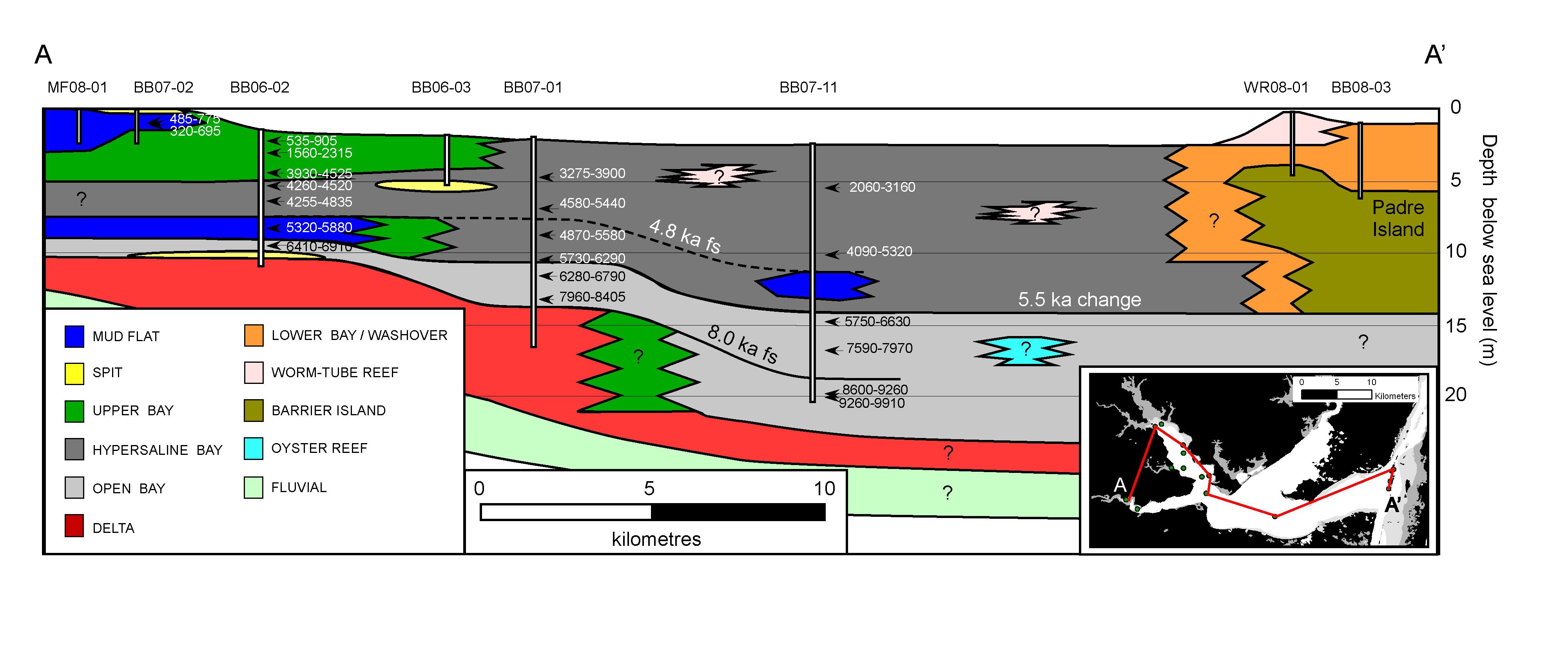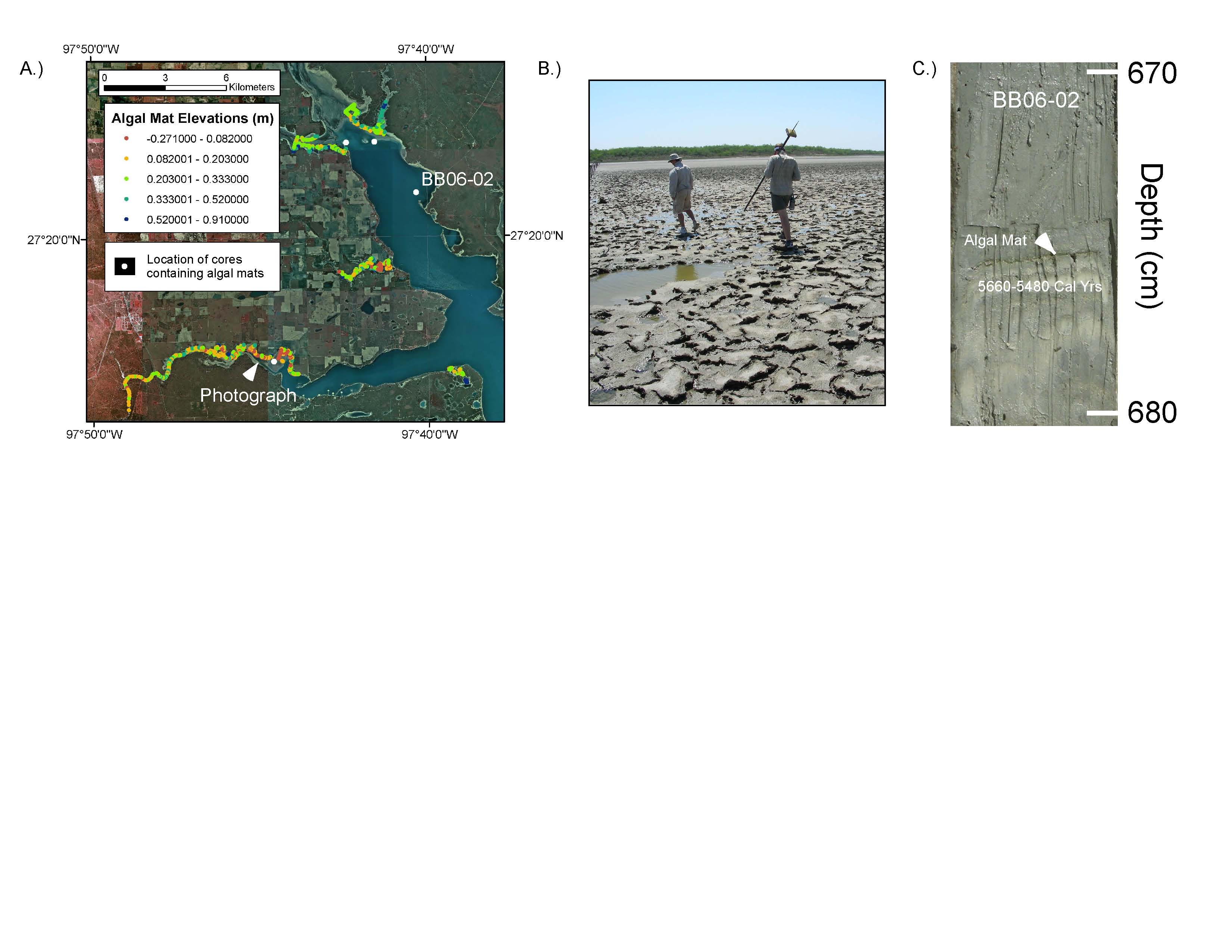Reports: GB8
44868-GB8 Controls on the Development of Mixed Siliciclastic/Carbonate Under-Filled Incised Valleys: Lessons from the Late Pleistocene/Holocene History of Baffin Bay, Texas
Alexander Ray Simms, Oklahoma State University
During the past year we finished
our analysis of the cores taken in Baffin Bay
including grain-size analysis, magnetic susceptibility measurements, and
radiocarbon dating. With the sedimentological work conducted on the cores completed, we were
able to reconstruct the history of Baffin Bay
and create a depositional model for the bay as a whole (Fig. 1). We found that Baffin Bay
underwent 3 major changes over the last 10 ka.
Around 8 ka, Baffin Bay experienced a
rapid landward backstepping of its bayhead delta in response to a global
increase in the rate of sea-level rise due to the 8.2-ka climate event. Around 5.5 ka, Baffin Bay underwent an
environmental change from a system similar to the bays further north and east
of Baffin Bay such as Corpus Christi Bay and Galveston Bay to those of the
system today. Around 4.8 ka, several
internal spits and mudflats were flooded.
We also finished describing the unique facies associated with the
depositional environments of the valley fill since 5.5 ka including prograding mud flats, shelly
internal spits, worm-tube reefs, and laminated central-basin deposits. A paper is in press in the journal Sedimentology summarizing our results.
One important outcome of this
research was the observation of the prevalence of algal mats on the subaerial portions of the mud flats of upper Baffin Bay (Fig. 2).
Fossil algal mats are also found in cores from Baffin Bay. We surveyed nearly
1300 algal mat elevations and found that 90% of them are found at elevations between
10 and 50 cm above mean sea level. We
used this data from this project to secure a larger National Science Foundation Grant to reconstruct paleo sea levels from the algal mats found in deposits from
Baffin Bay over the last 5 ky. This
larger project will allow me to continue my coastal research program started
with my PRF starter grant and fund a minimum of 2 more students.
We also collected 6 cores in
adjacent Copano Bay with lengths up to 17
m. This was done in order to test for
the occurrence of a spike in magnetic susceptibility found in cores from Baffin Bay around 8.2 ka.
The spike is present in cores taken from Copano Bay
as well as cores from Corpus Christi and Galveston Bays, Texas. We conducted XRF analysis on the cores to
determine if the spike in magnetic susceptibility was due to an increase in iron
delivered to the bay at that time. We
found no increase in the percentage of iron associated with the peaks in
magnetic susceptibility, but hypothesize that rapid deposition resulted in the
preservation of ferromagnetic minerals during periods of increased rates of sea-level
rise. X-Ray diffraction is being
conducted on the cores to determine if a change in mineralogy is associated
with the peaks in magnetic susceptibility.
Grain-size measurement from Copano Bay support our hypothesis.
This grant directly supported an
undergraduate research project. That
undergraduate student has decided to pursue a PhD after she completes her BS in
December of 2009. It also indirectly
supported another MS student who will also complete his degree in December of
2009. The grant was used to help fund
the collection of the cores that became the subject of his thesis.
In addition to the journal article
in press, we published another journal article in the Journal of Sedimentary Research.
This article outlines an evolutionary model for shallow ponds along the
shores of Baffin Bay and provides some constraints on the sea-level record
documented in cores from these shallow ponds and from Baffin Bay proper. 4 abstracts
were presented at national meetings as a result of this work. In addition, 4 more will be presented at the
October Annual Meeting of the Geological Society of America in Portland, Oregon,
including 2 by students.
Figure 1. Figure illustrating a landward (A) to seaward (A') profile through the deposits of the Baffin Bay incised valley system. Note the flooding surfaces (fs) and large depositional changes that occurred in the bay at 8, 5.5, and 4.8 ka (Simms et al., in press).
|

Figure 2. A.) Summary of the elevation of nearly 1300 algal mats in upper Baffin Bay, Texas, B.) photograph illustrating modern algal mats, C.) photograph of a nearly 5500-year old algal mat preserved in a core taken from Baffin Bay.
|







